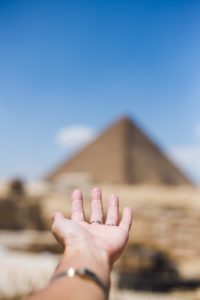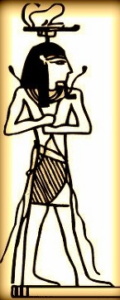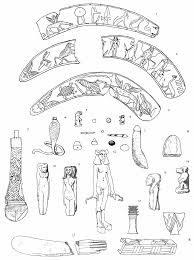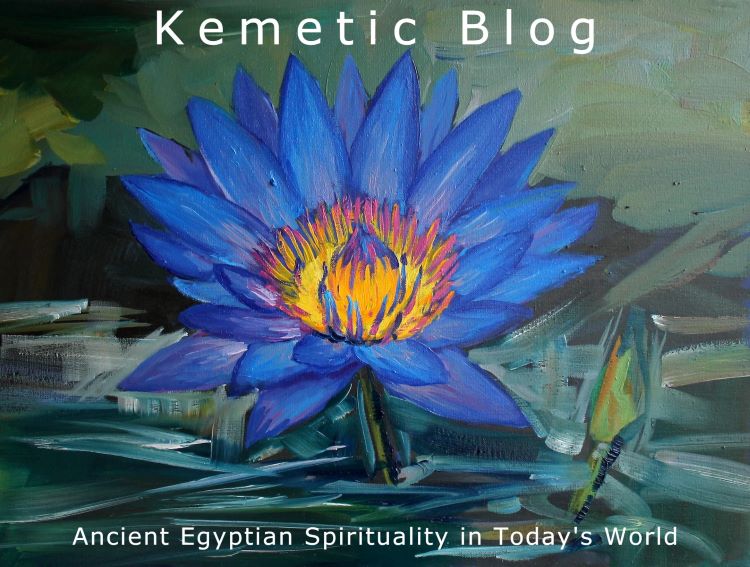
Photo by rosario janza on Unsplash
Heka — or ancient Egyptian magic — goes hand in hand with Kemetic spirituality. In fact, it’s hard to separate one from the other. Perhaps that’s because the ancient Egyptians lived in a world infused with magic.
In this fourth and final instalment of Kemetic Spirituality for Beginners, I’d like to demystify the mystical as much as possible, just as my teachers once did for me. The goal is to make each aspect of Kemetic spirituality as accessible as possible, including magic. In this post, I’ll endeavour to introduce magic from both the subjective and objective points of view, to give you a more comprehensive explanation of magic and how to make it work in your everyday life. Plus, I’ll share one of my own spells inspired by the Ramesseum Papyri.
To start, I recommend building your knowledge base by reading the 2020 book, Ancient Egyptian magic: A hands-on guide by Christina Riggs. Many a Kemetic would recommend this book and I’m on the same page with those practitioners. Riggs’ work draws from the historical record, which can lend credibility and authenticity to our practice. Some Kemetics, however, cleave to the idea of using only such information, as from academic sources in the field of Egyptology, or books that draw upon such sources. I think it’s a good idea to take the middle path. People can have heaps of authentic sources to inform their practice, yet have no authentic experiences. This, in my opinion, is the difference between reading about pools and jumping into one! So from there, I’ll delve into my own explanations of magic and share from my own background to give you a unique perspective and interpretation.
Approaching this article, I’ve pondered the question, what makes a good practitioner of magic?
I would say, it comes down to having a good command of yourself — knowing who you are — in both the physical and non-physical aspects of reality. When you are secure in both, when you are just as comfortable in one reality as you are in the other, you will become a well-grounded yet highly spiritual person. This is the sort of person who can hold a lot of light or information (see the 1992 book, Bringers of the Dawn by Barbara Marciniak). The physical and non-physical worlds complement one another — they are not at odds — and they are inter-connected. We naturally operate in both. When we take responsibility for our lives and become more proactive in the physical, we can naturally make things happen. Likewise, we can naturally make things happen when we’re proactive in the non-physical. Combine them both, and you have magic.
We need to reframe then, the term, magical thinking. Think of magic as something that is natural as opposed to supernatural. Think of magic in more practical terms and the world in more magical terms and you will integrate who you are; you will move in both realities. This is how I define magic: Magic is the movement of natural creative forces in the universe to produce desired effects. My own teacher, Wiccan author Scott Cunningham, emphasised the use of magic to create needed change (see the 1988 book, Wicca: A guide for the solitary practitioner). Simply put, magic is manifesting the life you want, need and deserve to have.
Magic, like everything else in the universe, is energy. Pure and simple. This energy carries its own innate intelligence and should be treated with respect and reverence. In ancient Egypt, magic was both a concept and a living deity, known as Heka, a god of magic and medicine — just as Ma’at is both a philosophy and a living goddess.

The god, Heka who holds two serpents crossing one another in his hands. The hind of a lion is the symbol on his head when depicted in magical form. Image by Heshbi via Wikipedia
In Kemetic spirituality, we honour Heka as the embodiment of magic, just as we honour Ma’at as the embodiment of order and balance over chaos and evil.
The above statement should give you a pretty good idea of how the ancient Egyptians thought magic should be employed; often to ward off evil and to provide prosperity, love, protection and to navigate the afterlife, or duat (see Raymond O. Faulkner’s version of The Ancient Egyptian Book of the Dead). That’s not to say curses didn’t exist in ancient Egypt. They did, and they usually focused on punishing those who violated the virtues of Ma’at. The most famous perhaps, were meant to protect the tombs of the pharaohs. Another popular ritual in Kemeticism is meant to disable the evil one, A / pop/ his, or Ap / ep. Note, we never write his name in whole, which is in itself a magical act to destroy his power. I, myself had a run-in with this being long before I ever became a Kemetic pagan — look for an upcoming post on that encounter!
When we are the victims of injustice or malice, it’s easy to forget that when practicing magic, we are working with Heka’s energy, who is a force for good in the universe. If we misuse that energy, there will be repercussions. Such repercussions are natural law. If you send a curse, you’ll receive one in return. In New Age circles, we call this the Law of Attraction. We attract what we think about, and the more we attract what we think about, the more we attract what we think about; and the more we attract what we think about the more we attract what we think about. Make sense? (See the 2009 book, Ask and it is Given: Learning to Manifest Your Desires by Esther Hicks).
We manifest both the positive and negative experiences in our lives and the best thing we can do is to learn from each one. That’s not to say someone diagnosed with cancer created it and deserves it, that’s absolute ignorance. Illnesses are complex issues that require a healing journey, which in itself opens doors to many opportunities. Be compassionate and you’ll receive compassion in return.
My own introduction to ancient Egyptian magic happened rather spontaneously, I am convinced, by the will of the gods. You can read about it in my post: An Unexpected Execration Ritual. Because I was resistant to perform magic at one point in my life, I missed the cues that signalled a ritual was in order. The gods performed it for me right in front of my eyes! The reason for my reluctance to perform magic was because once I cast a spell, which worked a little too well. Later, I regretted it. I attempted to undo the spell without success. When you start casting spells, be careful what you wish for. Better yet, be clear about what you want.
Well, I’ve given my theories, warnings, stories and lore about ancient Egyptian magic. Let’s cast a simple, but effective spell! This spell is a modern adaptation inspired by the Ramesseum Magician’s Tomb discovered in 1885-1886 and a box of magical papyri scrolls and ritual objects found within (see the British Museum’s archive of The Ramesseum Papyri). You’ll also find a reference to this material in the Riggs book.
First, you’ll need to cleanse yourself and your space, which I’ve covered in previous posts in the Kemetic Spirituality for Beginners series. If you’re in a pinch, take a natron bath or cleanse your hands with cool water to achieve wa’ab or ritual purity. Next pour libations, or liquid offerings to the gods; burn some incense (frankincense on a charcoal block, for example) and ask the netjeru to help you achieve your magical goal. I’m not going to use the exact words of ancient Egyptian priests because it’s important for you to think and use your own intuition; this is how you connect. Do this, then check out the papyri for yourself and see how similar your wording was; make a game of it. If you have an altar, go to it and set up the following items, which have been pre-cleansed by your incense:
- Small sheet of papyrus parchment paper
- Charcoal pencil
- Trinket box
- Piece of string
Because I’m a scribe, a lot of the magic I’ve performed over the years involves writing. In ancient Egypt, scribes used squills with ink made of charcoal but a charcoal pencil is more practical and easier. Think of your magical goal and write it down on a piece of papyrus parchment. If you’re not sure, consider writing: Clarity about what I want. Visualise Heka’s energy streaming down through your body, through the pencil and into the words and paper as you write. You may also wish to call upon other deities, such as Thoth, Isis or Sekhmet. Close your eyes and imagine the words and paper brimming with energy and light. See your goal becoming a reality and feel the emotions associated with your success. Hold that picture in your mind for a few moments then let it go. Place the papyrus in its special box or other container (preferably made of a natural material) and keep it either on your altar or in a secret place, if necessary. You might like to roll the papyrus and tie it with a piece of string, so it resembles a little scroll. You can add future spells and scrolls to the box, if you wish.
Magic is simple, or at least it should be, so don’t over think it. Thank the netjeru for their assistance and go about your day or night. Let it go and let the universe work for you. Trust the process. You just might be delighted by the results! Sometimes a spell doesn’t work and there’s usually a reason for it. If this happens, ask the netjeru for clarification, then watch for signs that may pop up, usually in the form of a message that grabs your attention or a scene playing out around you that appears to stand out from everything else. There will be your answer.
When I’m feeling low or stressed, I will often hear or see something about Egypt in an unexpected way, out of the blue and it let’s me know I am not alone. For example, one day I was in a bad mood about something, I can’t remember what (probably uni related) and I decided to watch a documentary about country singer, Shania Twain. Now, although I don’t listen to much country, I like Shania because of her positivity and her attitude. Not to mention her voice! Suddenly there she was, shooting a music video in Egypt with the pyramids in the background. What are the chances of a country singer shooting a video in front of the pyramids? Obviously the video has been around for quite some time, but I had never seen it. These are the sorts of signs and coincidences I’m talking about (See the 1993 book, The Celestine Prophecy by James Redfield).
Having said all the above, I’d recommend for newbies to ease into the practice of ancient Egyptian magic as just one aspect of Kemetic spirituality.
If you’ve been following the Kemetic Spirituality for Beginners series, you’ll be well on your way to establishing yourself as a Kemetic practitioner.
Magic and divination, which deserves a post of its own, are not the only parts or even the most important parts of Kemetic spirituality. The most important part of Kemetic spirituality is your evolution as a human being. Your spiritual growth and development are a big priority for the netjeru. Did you know that? It’s why they’re still close to the planet, hanging around, and why they haven’t blasted off somewhere else with better things to do. They care about our growth; that’s why they make themselves accessible to human beings. We wouldn’t be drawn to ancient Egypt otherwise.
The gods don’t need to be worshipped. They appreciate worship, because it helps energise their existence in our reality and by doing so, we are helping them help us. When we send out signals of worship, the netjeru send out signals of guidance back to us. The gods benefit from our growth and development because ultimately, we create more positivity and more possibilities for creativity in the universe, so that it may expand. This feeds the creative essence of love, or Atum, the Prime Creator and source. Our growth is reputed to be something that will culminate in the next big bang. How magic is that?
So before diving into magic, let the netjeru, guardians and guides get to know you first. Take the necessary steps to educate yourself and build up a good rapport with the ancient Egyptian energies you’re asking to work with. Would you like it if a stranger burst into your house and demanded to use your electricity to power their devices, eat your food and use your resources? Probably not. In most cases, the netjeru will already know who you are, but it’s still good manners to be polite and ask permission.
The deities respond very well to those who uphold Ma’at or balance, harmony and ethical conduct. Once you’ve established a connection with them, do your best to stay in your integrity. There’s nothing wrong with doing magic, just ensure you’re doing it for the right reasons.
If you don’t have a good working relationship established with the netjeru and you attempt to involve them in magic, you could end up attracting what I call astral bozos from non-physical realities, not the ancient Egyptian deities, at all. Search your heart and soul(s), examine your motivation and make sure you are in the right place within yourself, before you proceed. I find the universe often brings us what we need, which in turn, reduces the need for magic. If you feel there’s a need that’s gone unaddressed and magic is the only way to achieve it, then by all means, proceed.

Contents of the Ramsseum box. Image by Courtney McRae via Wikimedia
To become a powerful practitioner of ancient Egyptian magic, you must first excel in all areas of Kemetic spirituality. Do this, and you’ll begin raising power or increasing your attractiveness to positive forces in the universe, which will conspire on your behalf to manifest what you are asking for.
As you advance, virtually all of your thoughts, words and emotions, especially those focused with intention, become like spells. By the same token, all your actions become acts of magic. That’s because the universe is listening to you. Learn to eliminate wasteful thoughts and actions which do not bring you into alignment with your goal. That doesn’t mean you can’t let loose and chill out once in a while, and watch your favourite streaming platform. I’m not going to manifest Gilead just because I’m enjoying the latest season of The Handmaid’s Tale, yet when I’m focused I know things are going to happen because the universe responds to me. After thinking about something with intent and focus, after mere seconds, I automatically connect with that person, place, thing, or time period and begin receiving impressions and messages. Be careful what you focus on!
I have every confidence that anyone who works on their spiritual development can reach this point and beyond. Five ways you can excel on your path of Kemetic Spirituality and raise power are:
- Meditation – Don’t wrestle against intrusive thoughts, observe and let go like you’re a casual observer of clouds floating in the sky. Allow spontaneous messages and visions as they appear.
- Visualisation – This is an active exercise that uses the imagination, like a movie screen in your mind. If it doesn’t work for you, tell yourself a story instead. Narratives are just as powerful.
- Breathwork – A teacher of mine once called this belly breathing. Filling the lower lobes of the lungs replenishes the body with oxygen and brings vital life force into the chakras or energy centres of the body. Inhale through the nose and exhale through the mouth. Do this for a minute or two, followed by normal breathing when you meditate.
- Offerings – Making offerings to the deities strengthens your bond and helps them to have an energetic anchor point in your life. It’s like having good Wi-fi. You want to have a strong connection. With poor Wi-fi, you have to work harder and it takes longer to get things done, which can be very frustrating, yes? Enough said.
- Devotion – This in itself is an offering. Having a devotion keeps you pure of heart and in alignment with Ma’at, and it allows you to heal any transgressions when we muck up, which we all do because we’re human. My own devotion is the 42 Positive Confessions which I recite or pray with a Kemetic rosary.
An additional sixth way to increase your Kemetic Spirituality would be to attend a Kemetic worship service, as log as it does just that and you feel spiritually safe.
Do you have your own ideas about getting started in Kemetic spirituality? I’d love to hear from you! Thank you, for reading Kemetic Blog. I hope you enjoyed this post on Kemetic spirituality for beginners. Just by reading, you already have the ball rolling and are well on your way.

:: Acknowledgement of African Origin The author of Kemetic Blog acknowledges and respects the African ancestral origins of ancient Egypt, and recognises the practice of Kemetic paganism as a modern reflection of Traditional African Religion. ::
© Scott Rose / Kemetic Blog – All Rights Reserved.

5 Comments
Amanda
October 18, 2022 at 10:11 pmThanks! This is lovely and comprehensive
Scott Rose
October 19, 2022 at 11:49 amThanks, Amanda. Glad you enjoyed it. I haven’t forgotten about Sekhmet; a post for her is in the works. Next will be a Halloween post about a run in I had with A/pop/his.
Lawrence white
March 23, 2023 at 7:20 amThank you for this post, I want to get started in kemetic spirituality and your post helped a lot..I’m still not completely sure on what I need to do to practice kemetic spirituality daily, like is there a book a should follow with what I should do daily like prayer or setting up altars to the gods..I guess I’m still trying to find my way and learn exactly what I need to do. I’m still a little confused. Thank you and looking forward to speaking with you soon.
Scott Rose
March 29, 2023 at 10:31 amHi Lawrence, thank you for your kind comment. My apologies for the long delay! I got married on 3/3/23 and have been in quite a whirlwind this month.
First and foremost, the most important thing you need to practice Kemetic spirituality is yourself and your relationship with the gods (netjeru). There’s no right or wrong way to do this but I understand it’s natural to seek direction and guidance as to how you can best get started.
Sharon LaBorde is an excellent author and guide, you can find her on Youtube and her Kemetic Independent channel – https://www.youtube.com/@KemeticIndependent While I don’t agree with everything she’s done (it’s a long story), I still acknowledge her as a good teacher. But watch some of the people in her chat sessions, as they can be bullies who will try to shut you down to boost their own ego.
Kemetic Orthodoxy, which follows a modern-day pharaoh can be found at the House of Netjer – https://netjer.org/ I don’t know a great deal about them, TBCH. A lot of people seem to study with them, but they’re not forthcoming about it, then they start writing to you in Egyptian along with certain ideologies and assume you’ll automatically know what they mean if you’re really a Kemetic. I find it a bit odd!
There are a few different branches of Kemeticism, believe it or not and there’s sometimes friction between them. Try not to get involved in the ‘our way is the only right way’ type of discussions as they only waste energy. Most people use direct evidence from the historical record to guide their practice, which you can find in the sources I mentioned above but don’t become a slave to this idea.
As for myself, I am an intuitive Kemetic and I work with the netjeru directly, with no middle persons. I think for myself. It’s important to form your own opinion and not allow someone else to form it for you.
Hope that helps!
Scott Rose
March 29, 2023 at 10:38 am– Here are the prayers: 42 Positive Confessions for modern Kemetic practice, using the 42 Negative Confessions from the Papyrus of Ani https://www.kemeticblog.com/how-to-write-your-own-42-positive-confessions-for-modern-kemetic-practice-using-the-42-negative-confessions-from-the-papyrus-of-ani/
– Here’s how to set up an altar: Evolution of My Kemetic Altar and Shrine – Part Two https://www.kemeticblog.com/evolution-of-my-kemetic-altar-and-shrine-part-two/